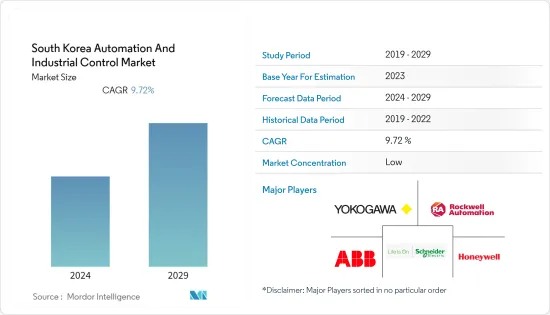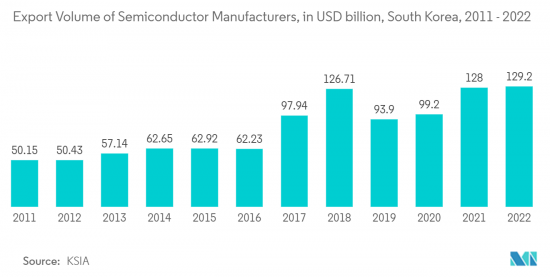PUBLISHER: Mordor Intelligence | PRODUCT CODE: 1406278

PUBLISHER: Mordor Intelligence | PRODUCT CODE: 1406278
South Korea Automation And Industrial Control - Market Share Analysis, Industry Trends & Statistics, Growth Forecasts 2024 - 2029

South Korea's automation and industrial control market was valued at USD 5.625 billion last year and is expected to reach a value of USD 9.69 billion by the end of the forecast period while registering a CAGR of 9.72% during the forecast period.
Key Highlights
- Factory automation and control solutions facilitate the automation of manufacturing/production facilities by designing and building fully integrated intelligent control systems, including robots, sensors, industrial equipment, computers, and advanced data processing solutions.
- Some prominent factors driving the growth of the market include the inclination of manufacturers toward cost-efficient processes, growing demand for the adoption of the Internet of Things (IoT) and machine-to-machine technologies, and significant automation of manufacturing processes. Automation of manufacturing processes offers several benefits, such as effortless monitoring, waste reduction, and enhanced production speed. This technology offers customers enhanced quality standardization and reliable products within time and at a much lower cost. Connecting industrial machinery/equipment and obtaining real-time data have been key in adopting SCADA, HMI, PLC systems, and visualization software, thus enabling the reduction of faults in the product, decreasing downtime, scheduling maintenance, and switching from reactive to predictive and prescriptive stages for decision-making.
- Furthermore, the virtualization of automation control systems is a key trend observed in the market, also known as the thin layer between the virtual machine and the host server. The virtual machine contains the operating system and software. Different operating systems are operated on top of a primary operating system using virtual machines. Virtualization can be applied on layers in an industrial premise, such as servers, storage, desktops, files, and networks. It provides benefits such as optimum resource utilization and savings of operation and power costs.
- Moreover, industrial system architects, integrators, and machine builders have leveraged connected computing advances to help manufacturing facilities function more efficiently. The upsurge in the requirement for real-time intelligence, better control of operations and scheduling, and increasing market penetration of big data analytics in the manufacturing industry are anticipated to further generate the demand for advanced process automation technology during the forecast period. Big data analytics facilitates an enterprise to use factory automation to shift from reactionary practices to predictive ones, a change that targets to improve the efficiency of the process and performance of the product. The increasing need for the adoption of advanced technology is likely to augment the development of the market studied.
- Automation equipment requires high capital investment to invest in smart manufacturing (an automated system can cost millions of dollars to install, design, and fabricate). The cost of purchasing the equipment, including robotic systems, conveyor belts, sensors, and control systems, can be substantial. The factory automation equipment also necessitates the customization and integration into existing production systems. This process involves designing, engineering, and programming the equipment to meet specific manufacturing requirements. The complexity of customization and integration adds to the overall costs. Moreover, installing automation equipment may require modifications to the existing infrastructure of the factory. These high costs discourage factory operators from choosing high-end industrial robots, challenging the market's growth.
- The COVID-19 pandemic forced many food and beverage manufacturers to automate their processes to minimize human intervention and prevent the spread of the disease. This aided the market's growth. Furthermore, the pandemic led to an increase in demand for network capacity and highlighted the need for robust and reliable 5G networks to support the growing digital needs of individuals and businesses.
South Korea Automation And Industrial Control Market Trends
Semiconductor and Electronics to Hold Major Market Share
- The production of semiconductors is a significant economic industry in South Korea, with a market share of 18%. According to the National Bureau of Asian Research, South Korea also plays a crucial role as a manufacturer of fabless semiconductor companies. Samsung Electronics is the second-largest manufacturer globally after TSMC. The government reports that semiconductors are South Korea's top export, accounting for approximately 18.9% of all exports in 2022, with exports representing 42% of GDP.
- As per the Korea Information Society Development Institute, the export value of semiconductors produced in South Korea reached approximately USD 129 billion in 2022, indicating a 0.9% rise from USD 128 billion in 2021. The International Federation of Robotics reports that South Korea deployed roughly 14,000 robots in its Semiconductor and Electronics sector in 2021. Such production capabilities and robotic installation activities are expected to bolster the market demand and automation technologies in the sector.
- As per the National Bureau of Asian Research, South Korea's GDP comprises 42% of exports, with semiconductors being the primary export item, contributing to almost 18.9% of total exports in 2022. The Korean administration prioritizes smart manufacturing and intends to establish 30,000 fully automated manufacturing firms by 2025, utilizing cutting-edge automation, data exchange, and IoT technologies. Such government initiatives in adopting automation technologies in the region are expected to drive the demand for the market.
- Several regional companies are constantly establishing strategic investments in building innovative manufacturing facilities to boost the region's semiconductor production capabilities. With the rising government initiatives to establish automated facilities, such investments are expected to drive the market significantly.
- Korean conglomerates are expediting the implementation of manufacturing automation solutions to enhance productivity, profitability, and cost reduction throughout the supply chain. The Korean government is encouraging businesses to embrace the digitalization of manufacturing and has identified four key themes: intelligence, services, sustainability, and platform. Due to this, various companies are adopting automation technologies and creating a positive outlook for the market.

Automotive Industry to be the Fastest Growing End User
- The South Korean automotive industry is one of the major global markets for vehicle sales and production of passenger cars. It currently contributes more than 10% of all manufacturing output in the country and is experiencing growth owing to significant investments. The industry is dominated by major automakers such as the Hyundai Motor Group, which owns Hyundai, Kia, and Genesis. As a result, South Korea wields significant influence in driving automation technologies in its Automotive industry.
- According to KAMA, In 2022, South Korea exported approximately 2.3 million units of vehicles, comprising passenger cars and commercial vehicles, representing a 15% increase from the previous year's 2.04 million units. In addition, In 2022, around 3.76 million units of vehicles were manufactured in South Korea. Kia Motors produced the highest number of vehicles, accounting for 39.4% of automobile sales in South Korea. These impressive manufacturing and sales capabilities are anticipated to stimulate the implementation of automation technologies in production facilities.
- Automobile manufacturers like Hyundai and General Motors Korea collaborate directly with additive manufacturers on the technology's application. Virtual and augmented reality also addresses manufacturing difficulties, such as machine failure, occupational injuries, and technical shutdown. Like many other industries, the auto industry wants to make the most of Industry 4.0, where "connected" machines communicate with one another and human operators to deliver workplace safety and productivity benefits. As a result, the rising need for automation in the vehicle industry affects automakers' attitudes about worker safety, resulting in a spike in the studied market.
- As of May 2023, electric vehicles (EVs) represented approximately 1.8% of the South Korean automobile market, as the Ministry of Land, Infrastructure and Transport reported. The government of South Korea has set a target to raise the proportion of electric and hydrogen vehicles in new vehicle sales to 33% by 2030. Furthermore, KAMA has stated that in 2022, domestic manufacturers sold approximately 123.7 thousand electric vehicles in South Korea, compared to 74 thousand units in 2021. Such developments in the EV sector will create significant opportunities for the vendor to invest in manufacturing facilities, thereby driving the market.
- Furthermore, according to the Ministry of Transport, South Korea is planning to establish safety regulations and an insurance framework for deploying Level 4 autonomous vehicles within the country by 2024. Additionally, in October 2022, Motional entered into a decade-long agreement to provide Hyundai's IONIQ 5 autonomous vehicles (self-driving robot taxis) to Uber Technologies Inc., a ride-hailing company based in the United States. Such activities are expected to drive the market further.
South Korea Automation And Industrial Control Industry Overview
The South Korean automation and industrial control market is highly competitive, featuring several major players in the industry. Leading companies like Schneider Electric SE, ABB Limited, Honeywell International Inc., Rockwell Automation Inc., and Yokogawa Electric Corporation continually invest significant resources in their research and development efforts to maintain a competitive edge.
In April 2023, Rockwell Automation announced its intention to form a partnership with Doosan Robotics, a renowned global robotics manufacturer, and its parent company, Doosan. The signing ceremony was attended by representatives from both organizations and South Korea's Minister of Trade, Industry, and Energy, Lee Chang-Yang. The agreement between Rockwell Automation (ROK) and Doosan is aimed at improving the integration of their robotic systems and controllers, with a focus on developing robotic and other automation technologies for applications such as smart factory construction and automation facilities worldwide. This collaboration is particularly significant for markets in the United States and South Korea.
In February 2023, ABB introduced its latest Distributed Control System (DCS) named ABB Ability Symphony Plus. This innovative product provides seamless and secure access to an extensive digital ecosystem for the power generation and water industries. ABB has launched this product to support the digital transformation in power generation and water industries. A key feature of this product is its support for viewing critical data from anywhere at any time, thanks to its HTML5 web-based operation and engineering tools. This functionality not only enhances plant uptime but also fosters collaboration and improves overall performance in these industries.
Additional Benefits:
- The market estimate (ME) sheet in Excel format
- 3 months of analyst support
TABLE OF CONTENTS
1 INTRODUCTION
- 1.1 Study Assumptions and Market Definition
- 1.2 Scope of the Study
2 RESEARCH METHODOLOGY
3 EXECUTIVE SUMMARY
4 MARKET INSIGHTS
- 4.1 Market Overview
- 4.2 Industry Attractiveness - Porter's Five Forces Analysis
- 4.2.1 Threat of New Entrants
- 4.2.2 Bargaining Power of Buyers/Consumers
- 4.2.3 Bargaining Power of Suppliers
- 4.2.4 Threat of Substitute Products
- 4.2.5 Intensity of Competitive Rivalry
- 4.3 Industry Value Chain Analysis
- 4.4 Assessment of The Impact of Macroeconomic Factors and COVID-19 on the Market
5 MARKET DYNAMICS
- 5.1 Market Drivers
- 5.1.1 Inclination of Manufacturers Toward Cost-efficient Processes
- 5.2 Market Challenges
- 5.2.1 High Cost of Installation and Re-building
6 MARKET SEGMENTATION
- 6.1 By Product
- 6.1.1 Programmable Logic Controller (PLC)
- 6.1.2 Distributed Control System (DCS)
- 6.1.3 Supervisory Control and Data Acquisition System (SCADA)
- 6.1.4 Human Machine Interface (HMI)
- 6.1.5 Process Safety Systems
- 6.1.6 Sensors and Transmitters
- 6.1.7 Electric Motors
- 6.1.8 Variable Frequency Drives
- 6.1.9 Industrial Robotics
- 6.1.10 Other Technologies
- 6.2 By End-user Industry
- 6.2.1 Automotive
- 6.2.2 Chemical and Petrochemical
- 6.2.3 Semiconductor and Electronics
- 6.2.4 Oil and Gas
- 6.2.5 Power Generation
- 6.2.6 Water and Wastewater
- 6.2.7 Other End-user Industries
7 COMPETITIVE LANDSCAPE
- 7.1 Company Profiles
- 7.1.1 Yokogawa Electric Corporation
- 7.1.2 Rockwell Automation Inc.
- 7.1.3 Honeywell International Inc.
- 7.1.4 ABB Limited
- 7.1.5 Schneider Electric SE
- 7.1.6 Emerson Electric Co.
- 7.1.7 Mitsubishi Electric Corporation
- 7.1.8 Siemens AG
- 7.1.9 Yaskawa Electric Corporation
- 7.1.10 Omron Corporation
- 7.1.11 CIMON Inc.
- 7.1.12 B&R Industrial Automation GmbH
- 7.1.13 Autonics Corporation
- 7.1.14 SICK AG
- 7.1.15 Renesas Electronics Corporation
8 INVESTMENT ANALYSIS
9 FUTURE OUTLOOK OF THE MARKET




